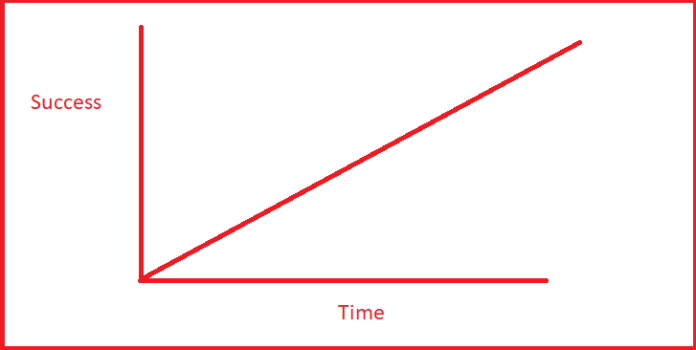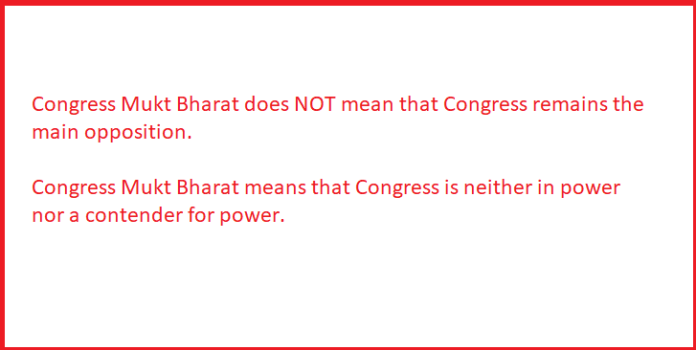As the BJP faces its biggest electoral setback in five years, it is easy for BJP supporters to give in to a sense of gloom and doom. It’s too soon for that.
Relax. Breathe. There are never full stops in politics. In every victory, there are seeds of defeat. In every defeat, there are seeds of victory.
Above all, I bet BJP supporters are asking: where did it all go? What happened to the dream? Will ‘Congress-mukt Bharat‘ become a reality or not?
Absolutely. Congress-mukt Bharat is unfolding in front of our eyes. Have no doubt about it.
In order to understand this, two key things are necessary. The first is to decode the peaks and troughs of electoral politics. The second is to understand what ‘Congress-mukt Bharat’ means.
You and I might want life to look something like this:

But we all know from our lived experiences that it never works like that. So why should politics be any different? Take a look at this graph instead :

This is a realistic graph of success in politics. There are peaks and then there are troughs. But the key is that the upcoming trough is around the same height as the previous peak. And that every successive peak is higher than the last one.
This is roughly the BJP’s trajectory. The Ram Temple movement took it to 120 in 1991 and then further ahead till Atalji achieved the peak of 160-180 in the late 90s. After that, the BJP declined in 2004 and 2009. But when it declined, the BJP’s number was around 110-130, in the same range as the peak of 1991.
In 2014, the BJP zoomed to 282, leaving far behind the Vajpayee peak of 182. It’s possible that 2019 might see a fall. Which is disheartening. But please remember that if BJP falls back to around 180, it is still beating the Vajpayee peak of 1996-1999.
Quite the opposite is happening with the Congress. For the Congress, each successive “peak” is now at the level of a trough from yesteryear.
The Congress used to be the party of 272 and beyond. For the Congress, 272 has long become a pipe dream.
What about 200 seats then? It might sound unreal today, but Rajiv Gandhi was so tremendously embarrassed by Congress winning “just 197 seats” in 1989 that he resigned. Instead, Janata Dal formed the government with 143 seats and V P Singh became Prime Minister.
Sonia Gandhi’s peak came in 2009 with 206 seats. Roughly the same as what Rajiv Gandhi got at his lowest point.
On the contrary, Sonia Gandhi’s lowest point came in 2014 when Congress couldn’t even secure the post of leader of Opposition with 44 seats.
Looking towards 2019, how many seats is Congress hoping to win? What is Rahul Gandhi’s peak? Somewhere around 120 seats. Perhaps even less than that.
That would put Rahul’s peak at the same level as Sonia Gandhi’s low point in 1999 when Congress got 114 seats.
Forget about winning majorities, the Congress today no longer even tries to be the single largest party.
The results of the recent Assembly elections show the same trend. The Congress has fallen short of a majority in both Rajasthan and Madhya Pradesh. This is nowhere compared to the resounding BJP victories in Madhya Pradesh in 2003, 2008 and 2013. This means that the last time the Congress won a majority in Madhya Pradesh would be 1998.
The same story holds in Rajasthan. BJP won thumping victories in 2003 and 2013. The Congress managed to form governments in 2008 and 2018, but couldn’t win a majority in either case. Again, the last time Congress won a majority in Rajasthan was in 1998. In 2008, the Congress managed a win by a 2% vote margin. In 2018, they eeked out a 0.5% vote share gap. The downward trend couldn’t be more obvious.
This may feel slow. One may complain that ‘Congress-Mukt Bharat‘ is taking too long. But you must factor in the size of the task. The British spent over 62 years building the Congress Party as their successors. When British rule was set to end, the country was partitioned between the Congress and the Muslim League. The Republic that we see today was tailor-made by Nehru and the British for Congress rule.
This was followed by 40 years of near-uninterrupted power held by the Nehru-Gandhi dynasty. Every road, every building, every public space was smothered with the brand of the Nehru-Gandhis. The concocted history of the Nehru-Gandhis is compulsory reading for every Indian child right from primary school. It will take time and patience to break a 100-year monopoly of the Congress Party.
Speaking of which, what is ‘Congress-mukt Bharat’ after all? It is time that BJP supporters understand what the term means… and more importantly, what it doesn’t mean:

A state like Uttar Pradesh is ‘Congress-Mukt’. So are Bihar and Bengal. So is Tamil Nadu. Congress can never come to power in these states. The newest state to become ‘Congress-mukt’ in Andhra Pradesh. It is YSR Congress and TDP that are the main contenders there. Congress doesn’t count.
One might suggest that Delhi is ‘Congress-mukt’ as well because it has become an AAP vs BJP contest. But considering the fickle nature of an urban electorate, we have to observe the state for at least one more election cycle before it can be declared ‘Congress-mukt’.
All the years when CPIM was ruling Bengal, the state was never Congress-mukt because it was always the main opposition. Today, however, Bengal has become Congress-mukt because of the TMC vs BJP fight, with CPM increasingly irrelevant and Congress in 4th place or worse.
In that sense, the whole question of Congress-mukt does not arise when it comes to Rajasthan, Madhya Pradesh and Chhattisgarh. Even though BJP was ruling them, Congress was very much present in these states. Even if BJP had won 3-0 yesterday, these states would still not have been Congress mukt.
And Gujarat is not Congress-mukt either, despite BJP winning 6 elections in a row. A state like Karnataka is much closer to becoming Congress-mukt because the Congress has already made a tactical concession to JDS. In the coming days, Congress may give up even more.
Another state where ‘Congress-mukt Bharat’ is in progress is Odisha. Now that BJP is emerging as the real alternative to BJD, Congress is losing all hope of ever getting back to power.
As for Gujarat, Chhattisgarh, Madhya Pradesh, Rajasthan, these states will never be Congress-mukt unless regional forces emerge that can replace Congress as the BJP’s main rival.
Until a few days ago, BJP supporters loved to show a map of India splashed all over with saffron, showing the extent of BJP rule. That map has gone sour since yesterday. But that map was never a good reflection of the state of the Congress-mukt Bharat project.
So, BJP supporters need to start focusing on a new map. Take the map of India and mark on it the states that are truly Congress-mukt and those which are not. Include UP, Bihar, Bengal, Tamil Nadu and Andhra Pradesh. Do not count Gujarat or Maharashtra or Assam. Now think about how the map of Congress-mukt states has changed over the years. You will find that it goes in only one direction: states become Congress-mukt and they never ever come back to the Nehru-Gandhi Dynasty. Congress-mukt Bharat is very much on.



